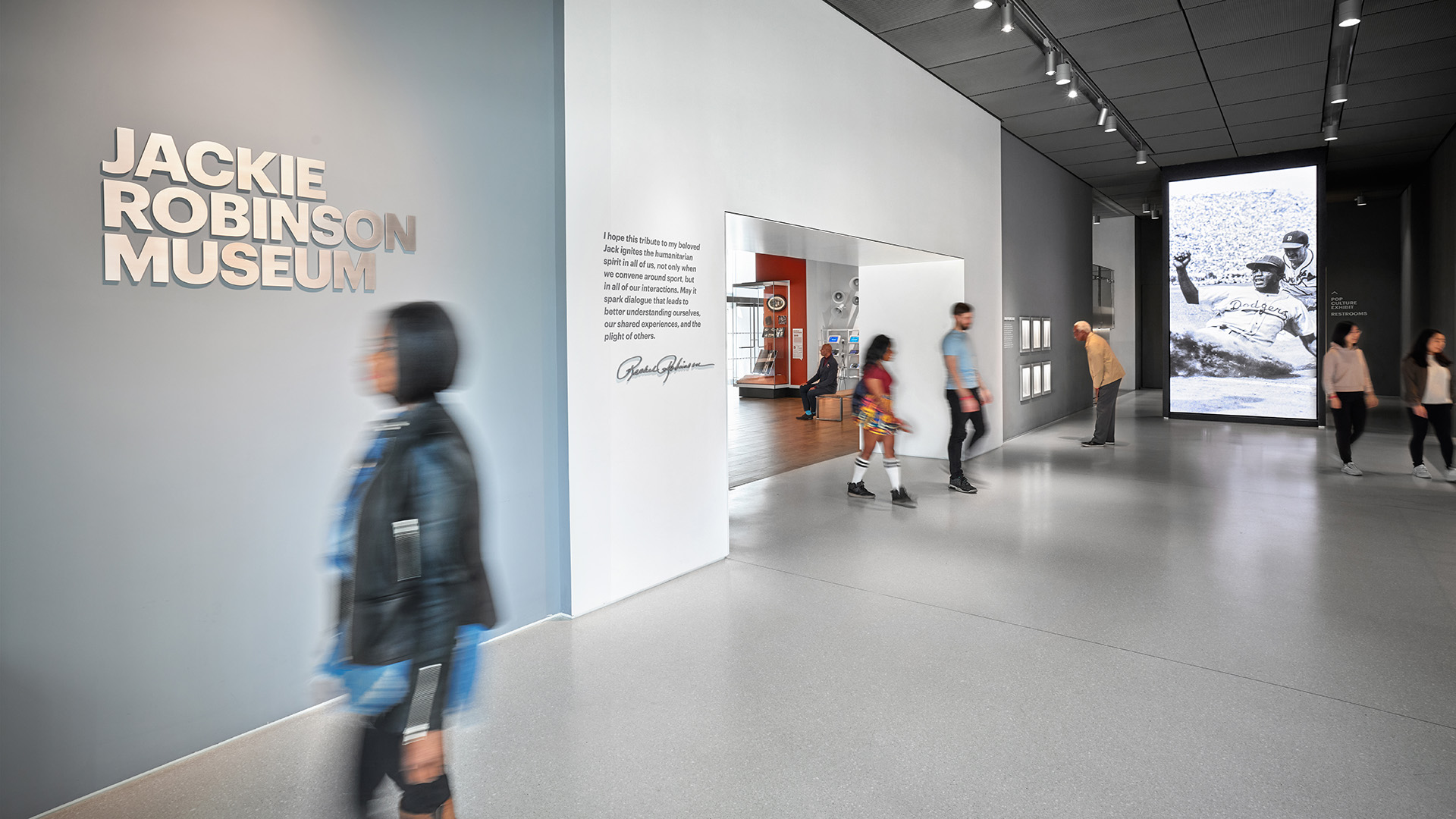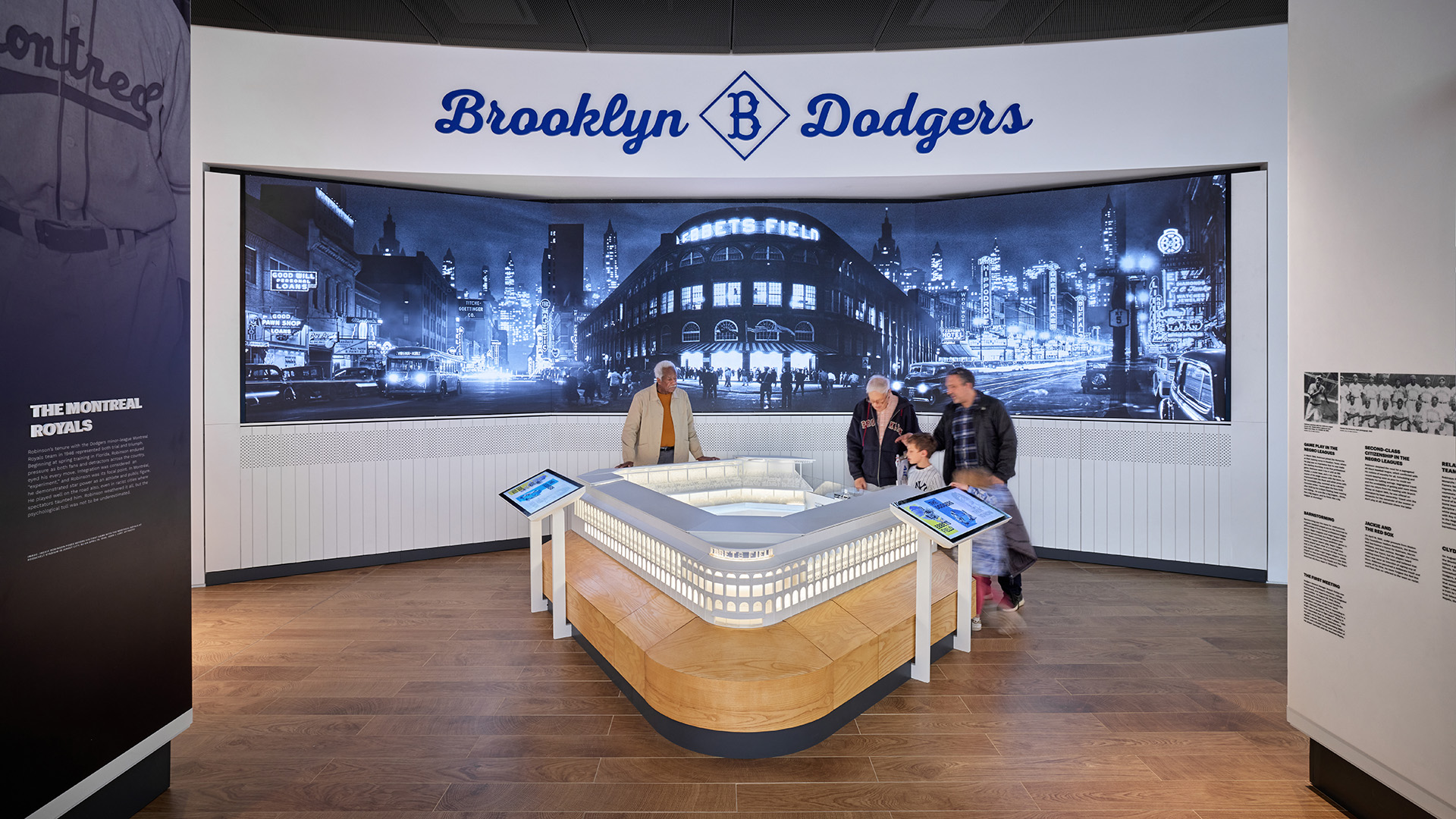The Jackie Robinson Museum

Located in a landmarked building in Lower Manhattan, the Jackie Robinson Museum inspires, educates, and challenges visitors of all types through Robinson’s athletic and personal achievements, civil rights leadership, and deep commitment to social justice.
When visitors arrive at the entry gallery, one of the first things they see is this welcome message from Robinson’s wife, Rachel:
“I hope this tribute to my beloved Jack is uplifting and ignites the humanitarian spirit in all of us, not only when we convene around sport, but in all of our interactions. May it spark dialogue that leads to better understanding ourselves, our shared experiences, and the plight of others.”
Here are some of the key moves we made in crafting an immersive exhibit that inspires visitors through Robinson’s legacy.

Celebrating the whole person
Upon entering the main gallery, visitors won’t immediately see any photos of Robinson in his Dodgers uniform, standing at the plate or sliding into home. Instead, they’re greeted with larger-than-life “story towers,” each focusing on a component of his life that visitors may not know about: he was an activist, an entrepreneur, a soldier, a father. Of course, we get to his phenomenal athletic career later in the exhibit, but this slight subversion of expectations at the start of the journey is a cue to visitors that this is a museum about more than baseball. It also offers multiple points of connection with visitors through the various facets of his life.

Big moves and small details
One of the signature exhibits is a technology-enhanced 1:64 scale model of Ebbets Field, where the Brooklyn Dodgers played. While the 30’ long media wall backdrop, immersive soundscape, and projection mapping on the field help transport visitors to a 1940s Dodgers game, equally impactful are the details: for example, the stands are filled with about 30,000 3D-printed fans with period-appropriate hats; and there’s a recreation of the Schaefer Beer advertisement above the scoreboard whose “h” or “e” lit up when there was a hit or an error. The stories follow a similar strategy, where visitors can go deep on major events like Robinson and his Dodgers teammates’ pennant-winning season, and they can also discover details of the culture around game day, like a well-known fan nicknamed “Howlin’ Hilda” and her cowbell. Visitors interact with the exhibit through a set of touchscreen rails, and the museum can add stories within the content framework.

Something for everyone
In order to inspire visitors, it was important to first understand their needs. A 2018 study published by the Gensler Research Institute applied Gensler’s Experience Index to museumgoers. The methodology included a series of roundtables, case studies, and an online survey of over 2,000 diverse respondents across the US. One of the key findings was around contradictory expectations with regards to technology: participants reported on the benefits in helping them understand the content on a deeper level, making the experience feel new and innovative, and offering opportunities for personalization. However, participants also craved an offline experience; a majority said it felt more authentic, less complicated, and could help them both focus and disconnect. The museum aims to satisfy both by using technology strategically throughout while letting some key artifacts speak for themselves.

Keeping it relevant
The museum was never intended to be a memorial; it’s an active celebration of Robinson’s legacy, and that demands an approach that’s conscious of and responsive to the world we’re living in now. One example of this is the exhibit, ‘Living Legacy’. It’s an array of 42 tablets with associated handheld speakers, and each one is a person – celebrities, athletes, former teammates, politicians, kids – that tells a story about how they were personally impacted by Robinson’s life. The museum can update and add to these, which helps create an exhibit that really is ‘alive’ – since people’s stories are shaped by and told through the lens of the world today.
Leveraging Gensler’s expertise in exhibit design and storytelling, the museum realizes the Jackie Robinson Foundation’s mission “to educate visitors about Robinson, the athlete, activist, patriot, entrepreneur and family man in historical context; to inspire those interested in the history of social change and in exploring the prescription for greater progress; and to challenge people of all ages to practice empathy and pursue a life of achievement and purpose.”